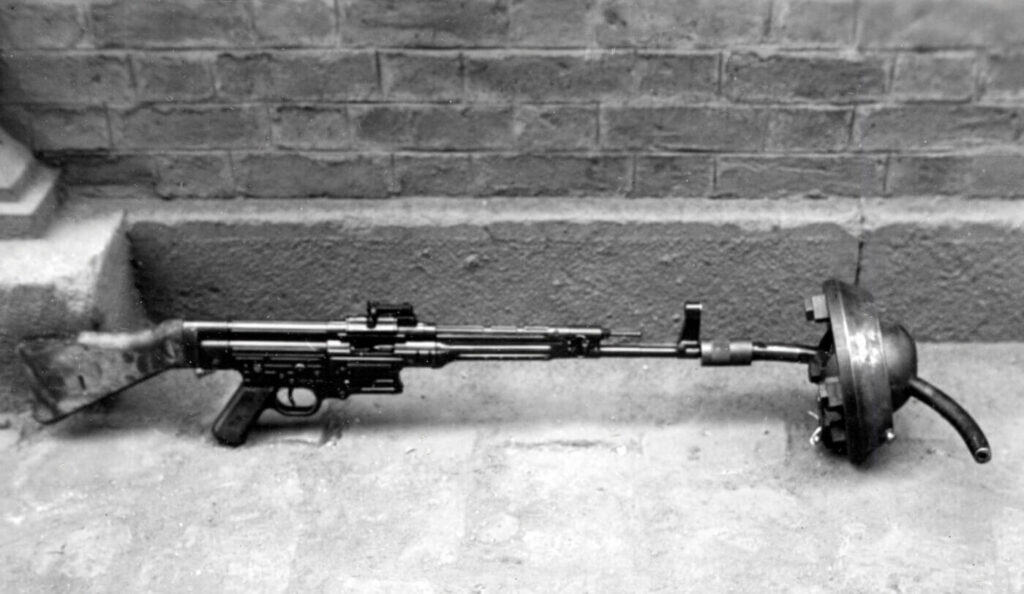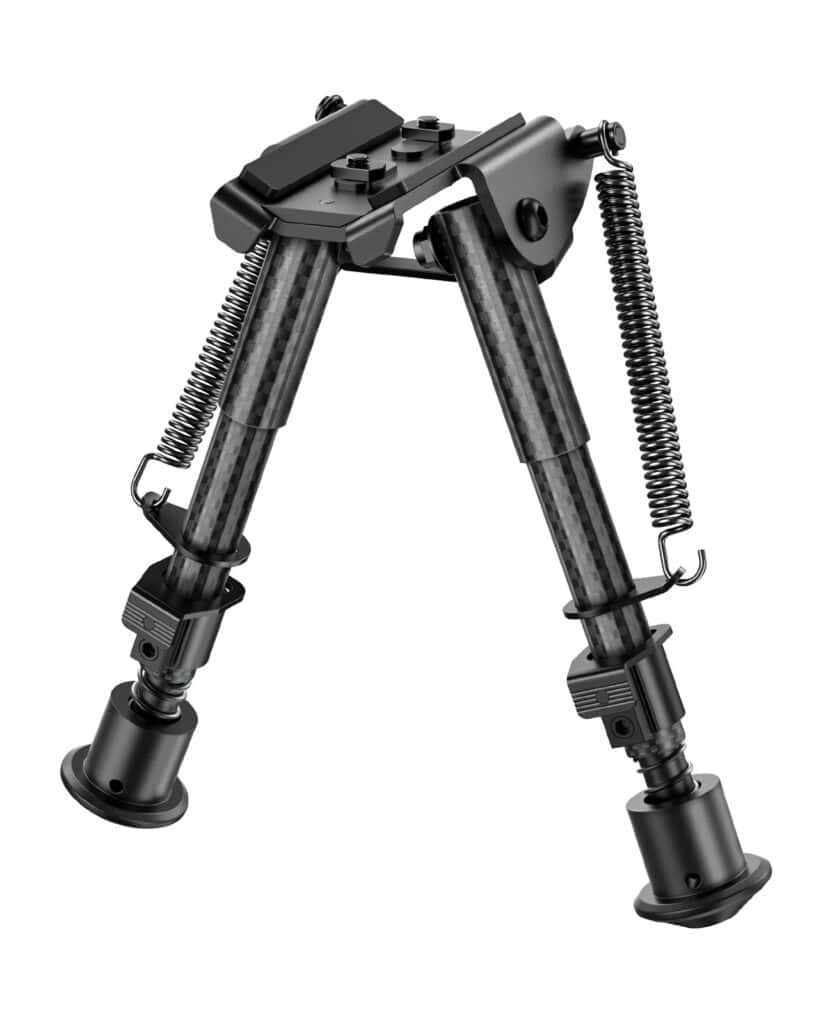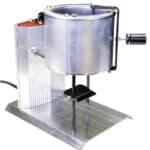
Introduction: When Ballistics Bent to Human Will
Some inventions in firearms history come across like something from pulp science fiction—concepts so peculiar and ambitious they seem impossible until you see them in metal. The Krummlauf attachment for the Sturmgewehr 44 (STG-44) is exactly that kind of marvel. Born in the crucible of late-war desperation and fueled by a mix of practical need and engineering bravado, this device remains one of the strangest—and most fascinating—experiments in small arms history.
Imagine a machine gun whose bullets curve around corners. Sounds like nonsense? It isn’t. In fact, it was tested, produced, and issued—at least in small quantities—by Nazi Germany during World War II. This is the true story of the Krummlauf, an insane but undeniably brilliant attempt to bend the rules of warfare, quite literally.
Part I: The STG-44—Birth of the Modern Assault Rifle
Before diving into the Krummlauf itself, we need to understand its parent firearm: the Sturmgewehr 44, or STG-44. Developed in Nazi Germany and fielded in 1943–1945, the STG-44 was the world's first mass-produced assault rifle, combining the firepower of a submachine gun with the range and accuracy of a rifle in a select-fire package. It chambered the intermediate 7.92×33mm Kurz cartridge, a revolutionary step that set the foundation for post-war designs like the AK-47 and M16.
The STG-44 was capable of both semi-automatic and fully automatic fire, used a detachable 30-round magazine, and featured exceptional controllability and range for a shoulder-fired weapon. But the Germans, always tinkering, weren’t content with straight-line destruction. They started asking: what if this already remarkable rifle could shoot around corners?
Part II: The Origin of the Krummlauf
Why Shoot Around Corners?
The genesis of the Krummlauf (German for “curved barrel” or “crooked path”) came from the practical nightmare of urban combat and tank warfare. Infantry had no good way to defend tanks from close-quarters ambushes—especially in cities where Soviet troops might climb onto a tank unseen or lie in wait around alley corners.
Tank commanders and crewmen needed a way to see and fire on enemies without exposing themselves. Enter the engineers at Rheinmetall-Borsig, who proposed a seemingly ludicrous but technically ingenious solution: a curved barrel extension for the STG-44 that allowed a shooter to fire at 30°, 45°, 60°, or even 90° angles. Paired with a periscope sighting device, this created an early analog version of what today’s tactical crowd might call “corner shot” systems.
Part III: The Krummlauf Variants
There wasn’t just one Krummlauf. In typical German fashion, the project spawned multiple versions, each specialized for a particular angle of bend and use case.
1. Krummlauf "I" (Infantry):
- 30° bend
- Intended for use by infantry behind cover.
- Featured a mirror sight to allow aiming while protected.
2. Krummlauf "P" (Panzer):
- 30° or 90° bend
- Designed to mount into tank cupolas.
- Came with a periscopic sight.
- Allowed tank crew to engage infantry in close quarters from within the vehicle.
3. 60° and 90° Experimental Types:
- These were heavily tested but not widely issued.
- Extreme angles introduced severe ballistic issues and barrel wear.
- Most broke or failed catastrophically after a few hundred rounds.
Part IV: Engineering Madness—How Did It Work?
A Curved Barrel? Seriously?
Yes. The Krummlauf was a rigid steel extension clamped to the end of the STG-44’s barrel. The inside was rifled, and the curve was manufactured with incredibly tight tolerances to guide the bullet along its arcing path. This wasn't merely a bent pipe—it was a precision-engineered extension.
Ballistics vs. Physics
Here's where it gets nerdy—and where the Germans started to lose the battle against physics:
- Barrel Pressure and Heat: As the bullet traveled the curve, it encountered dramatic increases in friction and stress. The bend disrupted the normal pressure curve, resulting in serious heat buildup and premature wear.
- Bullet Fragmentation: Especially in the 60° and 90° models, bullets would often fracture mid-barrel, emerging as shrapnel rather than a cohesive projectile.
- Accuracy: The 30° variant retained reasonable accuracy at close range—enough to hit man-sized targets at 100m. But anything more extreme was hopelessly inaccurate.
- Barrel Longevity: Early 30° prototypes lasted ~300 rounds before cracking. Later versions managed up to 3000 rounds with improved metallurgy and internal liners.
- Muzzle Velocity Loss: Depending on the bend and barrel length, velocity dropped by 15–30%. That’s a significant tradeoff, but acceptable for extremely short-range use.
Part V: The Optics and Mounting System
To aim around a corner, the shooter couldn’t use traditional iron sights. So, the Krummlauf came with an offset prism sight or mirror periscope, clamped to the side of the rifle. For tank mounts, a specially adapted periscope viewer let tankers look through the roof while shooting through the Krummlauf below.
Some versions even allowed the weapon to be clamped directly to the tank's interior and operated semi-remotely, making it one of the earliest examples of vehicle-mounted infantry weapons integrated into the main body of armor.
Part VI: Deployment and Field Use
Did It Actually See Combat?
Yes—but just barely.
The Krummlauf was tested extensively and saw limited fielding in 1944–45, particularly with Panzer divisions on the Eastern Front. German reports note mixed results:
- Tankers appreciated the protection it offered—but complained about jamming, overheating, and unreliability after extended fire.
- Infantry mostly saw it as a curiosity, with some using it experimentally in urban ruins during the Battle of Berlin.
Exact numbers are debated, but it’s estimated that less than 500 units were produced and fewer still were issued in operational conditions. Most were destroyed or captured by Allied forces, who were astonished at the sight of such an outlandish device.
Part VII: The Legacy of the Krummlauf
An Idea Too Far Ahead of Its Time?
While the Krummlauf was a technical failure in many ways, it laid conceptual groundwork for modern "shoot-around-corner" systems, such as:
- The CornerShot device used by special forces today.
- Robotic turrets and remote weapon stations, which owe a debt to early thinking about remote control and directional fire.
- Video- and periscope-assisted firearm designs.
Just as important, the Krummlauf represents a mindset of radical experimentation. Nazi Germany, particularly in the late stages of the war, was throwing every engineering trick at the wall, trying to find a miracle weapon to reverse its fortunes. Most of these ideas failed—but not all of them lacked value. The STG-44 itself proved profoundly influential, and the Krummlauf… well, it remains one of the boldest, most gloriously nerdy detours in firearms history.
Part VIII: Surviving Examples and Collectability
A few Krummlauf barrels exist in museums and private collections. The best-preserved examples are in:
- The Bundeswehr Military History Museum in Dresden, Germany.
- The National Firearms Centre in Leeds, UK (part of the Royal Armouries).
- The United States Army Ordnance Museum, though access varies due to relocations.
Collectors regard these as ultra-rare war curios, and when one comes up for sale (usually demilled or destroyed), the price can exceed $25,000—just for the Krummlauf attachment. Pair it with a matching STG-44 and you’ve got one of the most esoteric, desirable, and historically intriguing combinations in the firearms collecting world.
Final Thoughts: Engineering Insanity or Tactical Genius?
The Krummlauf is one of those rare inventions that straddles the line between absurd and brilliant. It wasn’t successful, but it was daring. It didn’t win any battles, but it remains unforgettable. More than anything, it represents the kind of wild-eyed, slide-rule-in-one-hand, grease-stained-blueprint-in-the-other kind of thinking that makes weapons history so endlessly fascinating.
In a war that saw jet aircraft, ballistic missiles, and infrared riflescopes emerge alongside horrifying atrocities and industrialized slaughter, the Krummlauf is a strange little side note that shows what can happen when engineers are told to bend reality—literally.

If you know of any forums or sites that should be referenced on this listing, please let us know here.




